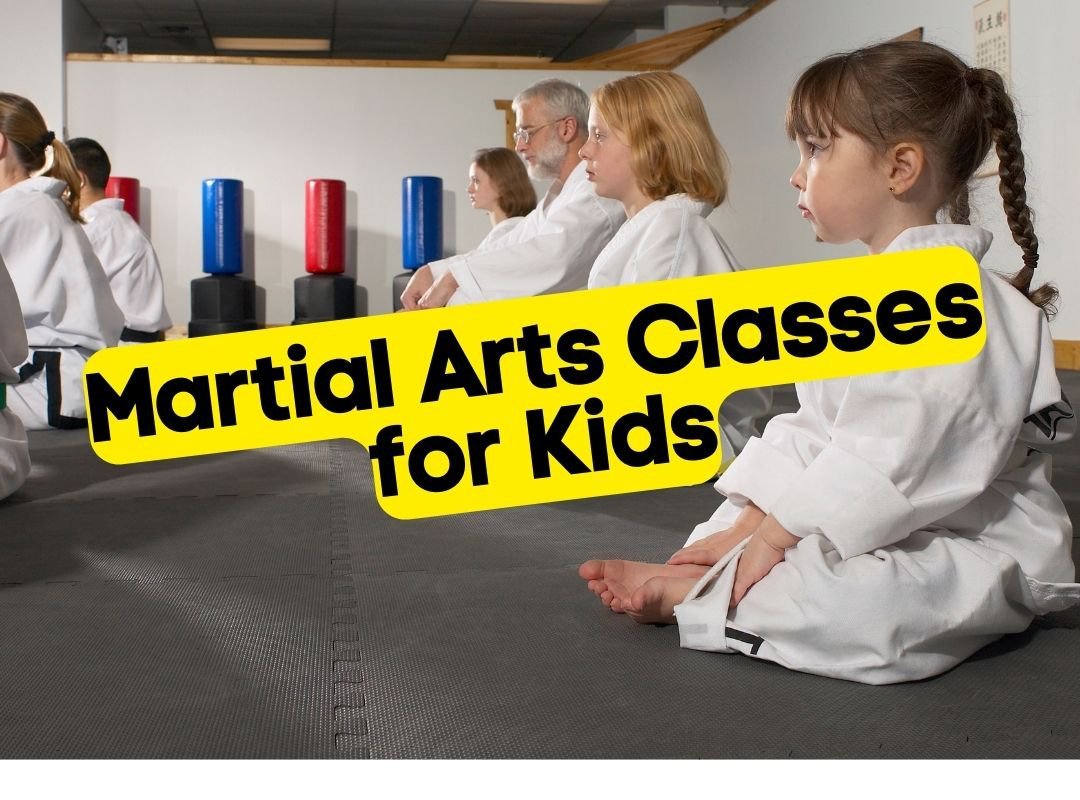Find Fun and Safe Martial Arts Classes for Kids

As a parent, you want the best for your children – including a safe and effective martial arts training program. But how do you find one that is right for your family? It's important to research to make the right choice for your child.
Start by looking at the types of martial arts classes available and their focus. Modern / Traditional martial arts like karate, tae kwon do, kumdo, kendo, and judo offer different physical and mental challenges. Some classes may be more suitable for younger children than others. Speak to a qualified instructor to better understand what is available in your area.
When choosing a martial arts class for your kids, ensure they know what they're signing up for. Martial arts can be intense and require commitment. Your child should be eager to learn and passionate about the particular type of martial arts they are getting involved in.
Safety is another key factor when selecting the best martial arts classes for your kids. Reputable martial arts schools should have strict safety regulations and guidelines, such as requiring protective equipment. Additionally, instructors should understand the importance of pacing for beginners, and the training should never involve compromising safety.
Finding your child's right martial arts training program is worth the effort. It can teach them valuable life skills and help build confidence and fitness – not to mention it can be a lot of fun!
Table of Contents
Unlocking Peak Performance: Tips for Choosing the Right Martial Arts Program for Your Child
Parents want what’s best for their children, and choosing the right martial arts class can be daunting. So how do you ensure your child gets the most out of their martial arts experience?
First and foremost, look for classes that specialize in teaching martial arts to children. Programs structured specifically for kids will provide young learners with an environment where they can safely learn and thrive. Additionally, instructors should be patient, encouraging, and certified in the style of martial arts they teach.
It’s also important to affirm that the school teaches age-appropriate techniques, not overly dangerous or complex. Kids’ martial arts classes should focus on basic techniques that instill discipline, respect, patience, and self-control, rather than martial arts moves designed for adults.
Another factor that should influence your decision is whether the school offers a variety of activities and events for your child. Look for classes that engage students with challenges, games, and competitions. These activities allow students to practice their skills, test their knowledge and build camaraderie with other students.
Finally, look for classes with a well-rounded curriculum. Learning the basics of self-defense is important, but kids also need to focus on physical fitness and mindfulness. A good program should encompass all three elements in its curriculum to enrich its students' experience.
At the end of the day, parents must ensure their child is in a safe and nurturing environment while they learn martial arts. By following these guidelines and researching schools carefully, parents can make the right choice for their children and guarantee they get the most out of their martial arts training experience.

Martial Arts: The Key to Unlocking Kids’ Full Potential!
Movement is key to any child's development; martial arts is an excellent way to achieve that. Martial arts training can help kids improve their physical fitness, coordination, self-esteem, and confidence. It can help enhance kids' focus and concentration while teaching them useful skills like goal-setting and perseverance. Kids often experience reduced stress and anxiety as they learn martial arts. Plus, the social aspects of martial arts classes offer valuable opportunities to make new friends, exercise in a fun and positive environment, and build key communication and problem-solving skills. Martial arts truly offer something unique for every child!
Martial arts training can offer numerous benefits for kids, including:
Improved physical fitness and coordination
Martial arts are a great way to help kids become more physically active and improve overall coordination. Through martial arts training, children can work to improve their balance, strength, speed, flexibility, and agility. With regular practice, kids can increase their physical awareness and find it easier to move gracefully and efficiently. Additionally, martial arts can help kids focus more on their physical well-being by teaching proper stretching techniques and body movements. This can lead to improved overall physical fitness and better mental alertness.
Enhanced self-esteem and confidence
Martial arts training can empower kids to become self-confident and increase their self-esteem. By learning martial arts, kids feel like they can take on any challenge, whether school or sports. As they practice and improve their skills, they develop a sense of accomplishment, boosting their confidence and character. They also learn respect for themselves and others, discipline, and how to manage emotions, all essential to achieving greater self-esteem.
Increased discipline and self-control
Martial arts training can benefit kids, from teaching them discipline and controlling their emotions to patience, respect, and focus. It's the perfect way for children to become more in tune with their physical and mental states and learn the important life skills that come with focused and disciplined mindfulness. Through martial arts training, kids learn to stay in control even when in challenging circumstances and focus on the task. This increased self-discipline can help them to manage their own behavior better, leading to improved academic performance, increased self-confidence, and better health overall.

Improved focus and concentration
Kids who participate in martial arts become more alert, and better able to focus and concentrate on tasks. The practice of martial arts forms the foundation of a child's physical and mental development. Their physical strength, coordination, and agility will improve, and their mental discipline, internal motivation, and self-awareness will also grow. Two benefits martial arts can offer kids are improved focus and concentration. Training in martial arts can help them become self-confident and accomplish goals that may have seemed difficult or impossible.
Reduced stress and anxiety
Training in martial arts can be a great way for kids to find peace and calm. Martial arts provide a great way for children to learn about being goal-oriented and using discipline – things that are beneficial for reducing stress and anxiety. In addition, martial arts classes can help participants learn to focus and clear their minds, allowing them to become more grounded and cope better with difficult situations. By teaching children the importance of dedication and self-control, martial arts classes can help them build their self-confidence, which can go a long way toward reducing stress and anxiety.
Opportunities to make new friends and build social skills
Martial arts training allows kids to engage in social and team activities, helping them build important social skills. Kids learn to work cooperatively to achieve common goals, build confidence in their own physical abilities, develop meaningful relationships with peers, and problem-solve while engaging in physical activity. Martial arts also instill important values such as discipline, respect, and responsibility, helping kids develop lifelong principles of respect and caring for themselves. With martial arts, kids learn how to be part of a larger community and develop better communication and teamwork skills, making them more well-rounded individuals.
Reduced symptoms of autism
Martial arts training can be incredibly beneficial for children, especially those with autism. With structured drills, routine practice, and precise movements, martial arts can help children manage social cues and disorder-specific behaviors while teaching them self-discipline, focus, and respect. The physical exertion and skill building of martial arts helps to reduce anxiety and improve concentration, which in turn can improve communication skills, behavior problems, and physical coordination. By challenging themselves in a fun and safe environment, children with autism can open up and gain other skills that will serve them well in and out of martial arts.

Choosing the Right Martial Arts Style
When choosing a martial arts style for your child, consider their interests, age, and physical abilities. Additionally, it's essential to research the various styles and speak with instructors to find a style that aligns with your child's goals and values.
There are numerous martial arts styles, each with unique techniques and philosophies.
Some of the most popular martial arts styles for kids include:
Karate
Karate is a Japanese martial art that involves unarmed fighting with kicks, strikes, and blocks. The word “karate” means “empty hand” in Japanese. Karate originated in the Ryukyu Kingdom (now Okinawa) and was influenced by Chinese martial arts, especially Fujian White Crane.
Taekwondo
Taekwondo is a Korean martial art that means "the way of kicking and punching." Taekwondo involves punching and kicking techniques, emphasizing head-height kicks, spinning jump kicks, and fast kicking techniques. Taekwondo is also a discipline that enhances our spirit and life through training our body and mind.
Kung Fu
Kung fu is a Chinese martial art that means “skill.” Kung fu is a form of exercise with a spiritual dimension stemming from concentration and self-discipline and a mode of personal combat that can be unarmed or with weapons. Kung fu also refers to any study, learning, or practice that requires patience, energy, and time to complete1.
Kumdo (Korean Style Martial Arts)
Kumdo is a Korean martial art that means “the way of the sword.” Kumdo is derived from Japanese Kendo and involves protective armor and practice swords between multiple practitioners. Kumdo is also a generic label for all Korean martial arts related to swordsmanship.
Finding the Right Martial Arts School
Once you've identified a martial arts style that interests your child, the next step is to find a reputable school. Some factors to consider when evaluating martial arts schools include:
- The instructor's qualifications and experience
- The school's safety record and policies
- The school's class schedule and location
- The school's teaching philosophy and curriculum
It's also a good idea to visit the school and observe a class to see how the instructor interacts with students and assess the overall atmosphere.

Safety Precautions for Kids in Martial Arts Classes
Safety should be a top priority when enrolling your child in martial arts classes. Some of the safety precautions that reputable schools should have in place include:
- Properly fitting safety gear, such as helmets and mouthguards
- Clear safety guidelines and rules
- Proper supervision during class
- Warm-up and cool-down exercises
- First aid and emergency procedures
Additionally, it's crucial to teach your child about the importance of safety and to encourage them to speak up if they feel uncomfortable or unsafe during class.
The Importance of Qualified Instructors
The quality of instruction can have a significant impact on your child's martial arts experience. Look for instructors who are qualified, experienced, and certified by reputable organizations. Instructors should have a deep understanding of the martial arts style they teach and should be able to communicate effectively with children.

Fun Martial Arts Games for Kids
Martial arts classes can be fun for kids, especially when instructors incorporate games and activities. Here are some fun martial arts games that can help keep your child engaged and motivated:
- Obstacle course: Create an obstacle course with cones, agility ladders, and other equipment. Challenge your child to complete the course in the shortest amount of time.
- Dodgeball: Incorporate martial arts techniques into a game of dodgeball. For example, players can dodge balls by using evasive maneuvers, such as rolling or ducking.
- Kickball: Play a game of kickball, but require players to use martial arts kicks instead of regular kicks.
- Sumo wrestling: Create a padded arena and have kids face off against each other in a friendly game of sumo wrestling.
- Kumdo: It's an exciting and dynamic way to learn self-defense, hone balance and focus with a bamboo stick (sword), and have a great time with friends.
Tips for Keeping Your Child Engaged in Martial Arts
To keep your child engaged and motivated in martial arts, consider these tips:
- Set goals: Work with your child to set achievable goals, such as earning a new belt or learning a new technique.
- Attend martial arts tournaments and competitions to help your child see the bigger picture and connect with the wider martial arts community.
- Offer rewards: Provide incentives for your child to attend classes and work hard, such as a small treat or a special outing.
- Encourage practice: Encourage your child to practice martial arts techniques at home to help reinforce what they learn in class.
Common Questions and Concerns about Kids and Martial Arts
Here are some common questions and concerns that parents have about enrolling their kids in martial arts classes:
Q: Is martial arts training safe for kids?
A: Yes, martial arts training can be safe for kids as long as proper safety precautions are in place, such as using appropriate safety gear and following safety guidelines.
Q: Will martial arts make my child violent?
A: No, martial arts training is not about violence. In fact, many martial arts programs emphasize discipline, respect, and self-control.
Q: How do I know if my child is ready for martial arts?
A: The best way to know if your child is ready for martial arts is to speak with instructors and observe a class to see how your child interacts with others and handles the activities.
Q: How often should my child attend martial arts classes?
A: The frequency of classes will depend on the program and the child's needs. However, attending classes at least once or twice a week is generally recommended for progress.
Q: Do martial arts classes help with self-esteem and confidence?
A: Yes, martial arts classes can help build self-esteem and confidence by providing a sense of accomplishment and promoting a positive self-image.
Martial Arts: A Roadmap for Kids to Stay Active, Learn and Have Fun!
Martial arts classes can be a great way for kids to stay active, learn valuable life skills, and have fun. By following the tips in this guide, you can help ensure that your child is participating in a safe and engaging program.

FAQs
What are some of the most popular martial arts styles for kids?
Martial arts are an excellent way for kids to develop physical and mental discipline while having a great time. There are various martial arts styles out there, ranging from traditional Karate or Taekwondo to the more modern Mixed Martial Arts (MMA).
Some of the most popular martial arts styles for kids include Judo, Jiu Jitsu, and Kung Fu, and Kumdo. Judo emphasizes throws and grappling techniques and helps children to gain confidence and practice self-defense. Jiu-Jitsu teaches children throws, joint locks, submission holds, and ground fighting skills. Kung Fu teaches a range of kicking, striking, and blocking techniques, respect, and discipline. Kumdo teaches physical discipline, mental focus, and respect for others. It is an excellent form of physical activity for children to learn and practice, as it helps build self-control and promotes healthy competition. Search “martial arts classes near me”
While each martial art has its own focus and benefits, they all share that it's a great activity for kids to stay physically active and learn discipline. Martial arts can also help boost your child’s concentration and teach them how to defend themselves.
What factors should I consider when choosing a martial arts school for my child?
When it comes to choosing a martial arts school for your child, there are several factors that you should consider before making a decision.
Firstly, you'll want to make sure the school is properly accredited and regulated by the correct governing body. This will ensure that the instructor and facility are qualified to teach martial arts correctly and safely.
Secondly, you'll need to consider the type of martial arts taught at the school. Different styles have different techniques, approaches, and philosophies, which you may need to research to decide what's best for your child.
Thirdly, look into the instructor's experience and qualifications, as this will give you an idea of their level of expertise. It's also worth looking into the class size because having more students in a class can decrease the safety and effectiveness of the training.
Finally, make sure to observe a few classes to get a feel for the school's atmosphere and see how your child responds to the instructions and teaching methods of the instructors. Doing so will give you a comprehensive picture of the program offered and help you make the right choice for your child.
How can I ensure that my child is safe during martial arts classes?
Keeping your child safe during their martial arts classes is a top priority.
First, make sure the environment is suited for children. Pay close attention to the instructor's teaching style, and if they seem to be pushing the kids too much or using overly aggressive techniques, it's best to look for another martial arts class.
Second, ensure your child always wears safety gear (such as a head guard, mouth guard, and another protective padding) when sparring or practicing with partners. This will help prevent any accidents from occurring.
Third, before enrolling in a class, ask to observe a session. This will give you a good idea of how the instructor interacts with the students and what safety protocols they have in place.
Finally, communicate regularly with your child about their class and ensure they're comfortable with all activities. A good relationship between student and instructor is key to having a safe and enjoyable experience in the martial arts classroom.
What are some fun martial arts games that kids can play?
Martial arts games for kids are a great way to teach them discipline and self-control in a fun and interactive way. Whether kids want to explore martial arts as a hobby or stay active, they can play plenty of fun martial arts games!
One game is "Ninja Tag," an intense version of tag. For this game, the players wear ninja masks and training swords and must use martial arts skills like blocking and dodging to take their opponents out. Another game is "Kung Fu Catch," Two teams are given colored belts and must try to capture each other's flag while defending their own. This game helps teach the basics of martial arts, like focus, agility, and speed. "Animal Karate" involves mimicking animal movements like a tiger or crane. This game teaches kids coordination, balance, and self-defense techniques. Lastly, “Sparring Bamboo” for Kumdo. It is played in two teams, where each team attempts to hit the other's bamboo stick without being hit themselves. This game provides an exciting way to master the skill and dexterity of kumdo while also engaging in friendly competition.
These are just some of the many fun martial arts games that kids can play. With patience and practice, any child can learn the fundamentals of martial arts while staying active, having fun, and building confidence in the process!
How can I keep my child motivated to attend martial arts classes?
Keeping your child motivated to attend martial arts classes is an important challenge for all parents.
One of the most important things you can do is make sure the classes are engaging and enjoyable. Martial arts classes should be fun, but also challenging. Make sure the classes are tailored to your child's age group and provide different activities that will keep your child motivated.
It can also help to discuss martial arts' importance in developing focus, discipline, and self-confidence. Talk to your child about how martial arts can build their endurance, strength, and coordination; or how it can help them learn how to control their emotions and reactions in times of stress.
In addition, provide incentives for good behavior, such as rewards for attendance or good performance in class. Regularly discuss with your child what they have learned in class, ask questions, and show an interest in their progress. Lastly, set realistic goals together with your child that they can work towards, such as mastering a certain technique or improving their sparring skills. This will help to keep them motivated and focused on the long-term results of their hard work.














